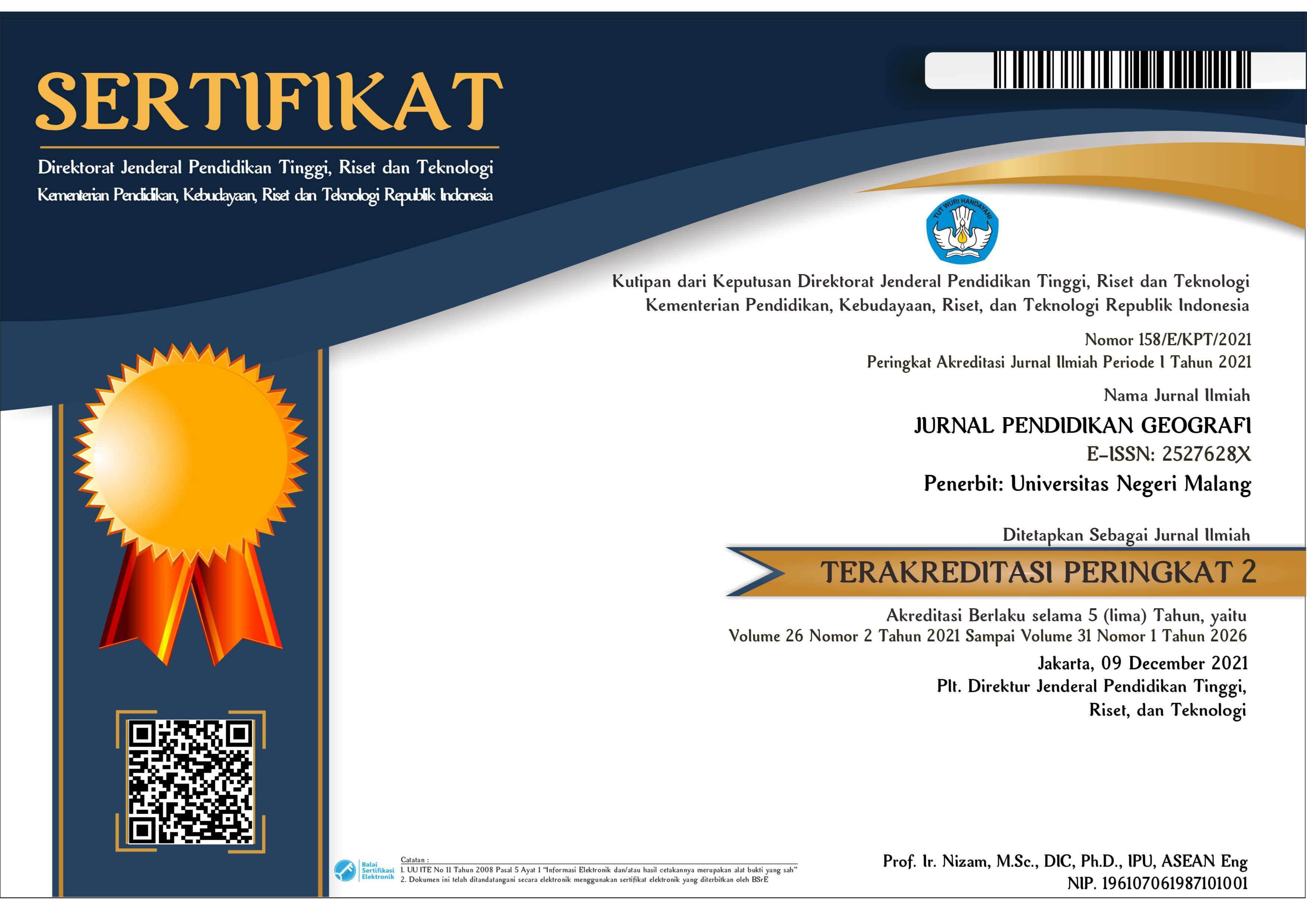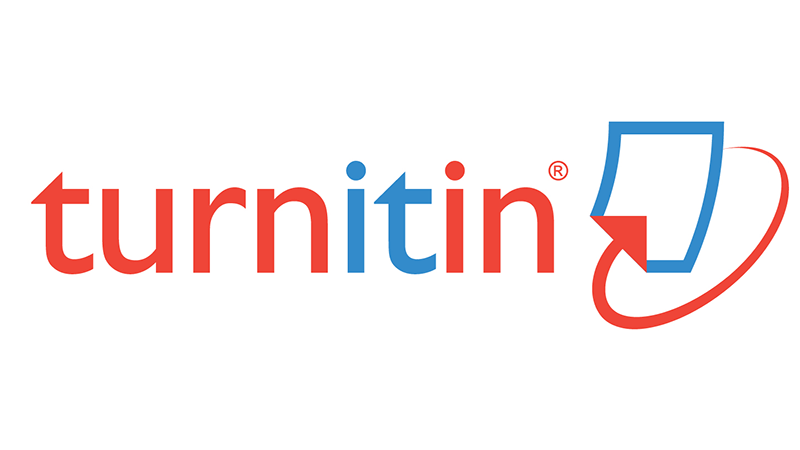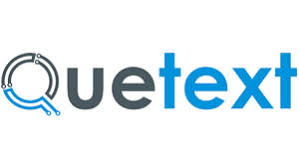ArcGIS story maps in improving teachers’ Geography awareness
Abstract
The purpose of this study is to examine the use of story maps in increasing sustainable Geography awareness among Geography teachers. The advent of story maps has altered the current Geography education in the digital era. ArcGIS story maps are a type of user-friendly geospatial technology renewal. This story map is believed capable of helping students learn Geography more independently, transforming Geography education. This belief should be reinforced by implementing story maps on their own Geography teachers, who have low Geography literacy rates in general. This action research involved 67 Geography teachers who were members of the East Java Geography Teacher Working Group, with various backgrounds, ages, and teaching experiences. Learning is implemented using blended learning and the in-on-in model. With blended project-based learning, this research was conducted to solve problems related to high school teachers' low Geography awareness. To identify the effects of the treatment, the obtained data were analyzed using a different test with paired t-test. The findings showed that story maps could increase long-term geographic awareness, illustrated by the obtained significant level of more than 0.05. This success is influenced by teachers' knowledge and experience with geospatial technology, as well as their age. Although the ability to create story projects is limited, the use of story maps provides a meaningful experience for teachers to think, reason, and act geographically.
Keywords
Full Text:
PDFReferences
Alemy, A., Hudzik, S., & Matthews, C. N. (2017). Creating a user-friendly interactive interpretive resource with ESRI’s ArcGIS Story Map Program. Historical Archaeology, 51(2), 288–297. https://doi.org/10.1007/¬s41636-017-0013-7
Balderstone, D. (2006). Now reading secondary Geography handbook.
Cope, M. P., Mikhailova, E. A., Post, C. J., Schlautman, M. A., & Carbajales-Dale, P. (2018). Developing and evaluating an ESRI Story Map as an educational tool. Natural Sciences Education, 47(1), 180008. https://doi.org/10.4195/nse2018.04.0008
Dumont, M., Touya, G., & Duchêne, C. (2020). Designing multi-scale maps: Lessons learned from existing practices. International Journal of Cartography, 6(1), 121–151. https://doi.org/10.1080/¬23729333.-2020.¬1717832
Egiebor, E. E., & Foster, E. J. (2019). Students’ perceptions of their engagement using GIS-Story Maps. Journal of Geography, 118(2), 51–65. https://doi.org/10.1080/00221341.2018.1515975
Esri. (2021). Apa itu ArcGIS Story Maps? —ArcGIS StoryMaps.
Glowa, J. G. E. (2016). Student-centered learning: Functional requirements for integrated systems to optimize learning. Aurora Institute.
Goldman, D. (2017). Cultivating engagement through student-centered learning in a high school media art class. Graduate Master’s Theses, Capstones, and Culminating Projects. https://doi.org/https://doi.org/-10.33015/¬dominican.edu/2017.edu.08
Groshans, G., Mikhailova, E., Post, C., Schlautman, M., Carbajales-Dale, P., & Payne, K. (2019). Digital story map learning for STEM disciplines. Education Sciences, 9(2). https://doi.org/10.3390/educsci9020075
Gutting, R., Hübsch, B., Meinel, G., & Wende, W. (2019). Spatial storytelling in man and environment education–possibilities and limitations of the ESRI “Story Maps“ editorial system. Naturschutz Und Landschaftsplanung, 51(8), 382–388.
Hattie, J. (2015). The applicability of visible learning to higher education. Scholarship of Teaching and Learning in Psychology, 1(1), 79–91. https://doi.org/http://dx.doi.org/10.1037/stl0000021
Hong, J. E., & Stonier, F. (2015). GIS in-service teacher training based on TPACK. Journal of Geography, 114(3), 108–117. https://doi.org/10.1080/00221341.2014.947381
Jo, I., & Bednarz, S. W. (2014). Developing pre-service teachers’ pedagogical content knowledge for teaching spatial thinking through Geography. Journal of Geography in Higher Education, 38(2), 301–313. https://doi.org/10.1080/03098265.2014.911828
Johnson, C., Price, M., MacDonald, G., Moseley, W. G., Wright, D., & Murphy, A. B. (2020). Geography: Why it matters. The AAG Review of Books, 8(1), 34–42. https://doi.org/10.1080/2325548x.2020.1689054
Kallaher, A., & Gamble, A. (2017). GIS and the humanities: Presenting a path to digital scholarship with the Story Map app. College and Undergraduate Libraries, 24(2–4), 559–573. https://doi.org/10.1080/-10691316.2017.1327386
Kerski, J. J. (2013). Understanding our changing world through web-mapping based investigations. Journal of Research and Didactics in Geography, 2(2), 11–26. https://doi.org/10.4458/2379-02
Kerski, J. J. (2015). Geo-awareness, geo-enablement, geotechnologies, citizen science, and storytelling: Geography on the world stage. Geography Compass, 9(1), 14–26. https://doi.org/10.1111/gec3.12193
Lee, D. M. (2018). A typological analysis of South Korean primary teachers’ awareness of primary Geography education. Journal of Geography, 117(2), 75–87. https://doi.org/10.1080/00221341.2017.1313302
Lee, D. M. (2019). Cultivating preservice geography teachers’ awareness of Geography using Story Maps. Journal of Geography in Higher Education, 44(3), 387–405. https://doi.org/10.1080/¬03098265.¬2019.¬1700487
Loomis, S. (2019). A review of debates in Geography education, 2nd edition through three lenses. The Geography Teacher, 16(1), 37–42. https://doi.org/10.1080/19338341.2018.1524782
Malek, S. A., Jaafar, M., Aiyub, K., & Mayalagu, G. (2020). Higher-order thinking skill (Hots) strengthening potential through the gis story map application in history subjects. International Journal of Advanced Science and Technology, 29(1), 801–814.
Marta, M., & Osso, P. (2015). Story Maps at school: Teaching and learning stories with maps. Journal of Research and Didactics in Geography (J-READING), 2, 61–68. https://doi.org/10.4458/6063-05
Mishra, P. (2019). Considering contextual knowledge: The TPACK diagram gets an upgrade. Journal of Digital Learning in Teacher Education, 35(2), 76–78. https://doi.org/10.1080/21532974.2019.1588611
Mukherjee, F. (2019). Exploring cultural Geography field course using story maps. Journal of Geography in Higher Education, 43(2), 201–223. https://doi.org/10.1080/03098265.2019.1597031
Mukherjee, S. (2016). Towards visual Geography: An overview. Practising Geographer, 19(2), 13–22.
Open University. (2016). Teaching secondary Geography. Retrieved from https://www.open.edu/openlearn/-ocw/mod/¬oucontent/view.php?id=48124&printable=1
Patterson, J., & Bickel, A. (2016). Communicating local relevance of ocean observations: Integrating real-time ocean sensor data visualizations, online communications, and ocean issues to engage public audiences. OCEANS 2016 MTS/IEEE Monterey, OCE 2016. https://doi.org/10.1109/OCEANS.2016.7761325
Patterson, T. C. (2007). Google earth as a (not just) geography education tool. Journal of Geography, 106(4), 145–152. https://doi.org/10.1080/00221340701678032
Purwaningsih, E., Sari, A. M., Yuliati, L., Masjkur, K., Kurniawan, B. R., & Zahiri, M. A. (2020). Improving the problem-solving skills through the development of teaching materials with STEM-PjBL (science, technology, engineering, and mathematics-project based learning) model integrated with TPACK (technological pedagogical content knowledge). Journal of Physics: Conference Series, 1481(1). https://doi.org/10.1088/1742-6596/1481/1/012133
Purwanto, P., Utaya, S., Handoyo, B., & Bachri, S. (2020). Transformation of geospatial technology knowledge in pre-service and experienced geography teachers as pedagogical tools in the technological-pedagogical-content knowledge framework. International Journal of Learning, Teaching and Educational Research, 19(9), 58–76. https://doi.org/10.26803/ijlter.19.9.4
Robinson, A. C., Kerski, J., Long, E. C., Luo, H., DiBiase, D., & Lee, A. (2015). Maps and the geospatial revolution: teaching a massive open online course (MOOC) in geography. Journal of Geography in Higher Education, 39(1), 65–82. https://doi.org/10.1080/03098265.2014.996850
Schultz, R. B., Kerski, J. J., & Patterson, T. C. (2008). The use of virtual globes as a spatial teaching tool with suggestions for metadata standards. Journal of Geography, 107(1), 27–34. https://doi.org/10.1080/-00221340802049844
Strachan, C., & Mitchell, M. (2014). Teachers’ perceptions of esri story maps as effective teaching tools. Review of International Geographical Education Online, 4(3), 195–220.
Vujakovic, P. (2020). The map is the story: The u-shaped line in western news media coverage of the geopolitics of the South China Sea. International Journal of Cartography, 6(2), 179–201. https://doi.org/10.1080/-23729333.2018.1541581
DOI: http://dx.doi.org/10.17977/um017v27i22022p206-218
Refbacks
- There are currently no refbacks.
Copyright (c) 2022 Jurnal Pendidikan Geografi: Kajian, Teori, dan Praktek dalam Bidang Pendidikan dan Ilmu Geografi

This work is licensed under a Creative Commons Attribution-ShareAlike 4.0 International License.
Jurnal Pendidikan Geografi: Kajian, Teori, dan Praktek dalam Bidang Pendidikan dan Ilmu Geografi is licensed under Creative Commons Attribution-ShareAlike 4.0 International License,
JPG Indexed By:
View My Stats








12.png)
